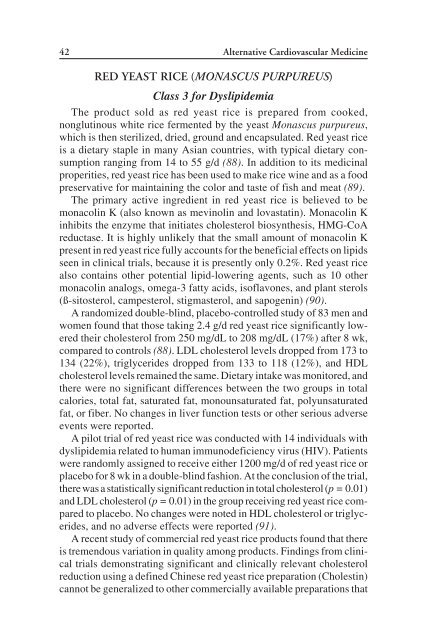Complementary Alternative Cardiovascular Medicine
Complementary Alternative Cardiovascular Medicine
Complementary Alternative Cardiovascular Medicine
Create successful ePaper yourself
Turn your PDF publications into a flip-book with our unique Google optimized e-Paper software.
42 <strong>Alternative</strong> <strong>Cardiovascular</strong> <strong>Medicine</strong><br />
RED YEAST RICE (MONASCUS PURPUREUS)<br />
Class 3 for Dyslipidemia<br />
The product sold as red yeast rice is prepared from cooked,<br />
nonglutinous white rice fermented by the yeast Monascus purpureus,<br />
which is then sterilized, dried, ground and encapsulated. Red yeast rice<br />
is a dietary staple in many Asian countries, with typical dietary consumption<br />
ranging from 14 to 55 g/d (88). In addition to its medicinal<br />
properities, red yeast rice has been used to make rice wine and as a food<br />
preservative for maintaining the color and taste of fish and meat (89).<br />
The primary active ingredient in red yeast rice is believed to be<br />
monacolin K (also known as mevinolin and lovastatin). Monacolin K<br />
inhibits the enzyme that initiates cholesterol biosynthesis, HMG-CoA<br />
reductase. It is highly unlikely that the small amount of monacolin K<br />
present in red yeast rice fully accounts for the beneficial effects on lipids<br />
seen in clinical trials, because it is presently only 0.2%. Red yeast rice<br />
also contains other potential lipid-lowering agents, such as 10 other<br />
monacolin analogs, omega-3 fatty acids, isoflavones, and plant sterols<br />
(ß-sitosterol, campesterol, stigmasterol, and sapogenin) (90).<br />
A randomized double-blind, placebo-controlled study of 83 men and<br />
women found that those taking 2.4 g/d red yeast rice significantly lowered<br />
their cholesterol from 250 mg/dL to 208 mg/dL (17%) after 8 wk,<br />
compared to controls (88). LDL cholesterol levels dropped from 173 to<br />
134 (22%), triglycerides dropped from 133 to 118 (12%), and HDL<br />
cholesterol levels remained the same. Dietary intake was monitored, and<br />
there were no significant differences between the two groups in total<br />
calories, total fat, saturated fat, monounsaturated fat, polyunsaturated<br />
fat, or fiber. No changes in liver function tests or other serious adverse<br />
events were reported.<br />
A pilot trial of red yeast rice was conducted with 14 individuals with<br />
dyslipidemia related to human immunodeficiency virus (HIV). Patients<br />
were randomly assigned to receive either 1200 mg/d of red yeast rice or<br />
placebo for 8 wk in a double-blind fashion. At the conclusion of the trial,<br />
there was a statistically significant reduction in total cholesterol (p = 0.01)<br />
and LDL cholesterol (p = 0.01) in the group receiving red yeast rice compared<br />
to placebo. No changes were noted in HDL cholesterol or triglycerides,<br />
and no adverse effects were reported (91).<br />
A recent study of commercial red yeast rice products found that there<br />
is tremendous variation in quality among products. Findings from clinical<br />
trials demonstrating significant and clinically relevant cholesterol<br />
reduction using a defined Chinese red yeast rice preparation (Cholestin)<br />
cannot be generalized to other commercially available preparations that


